Jan 12, 2018 | coins, commemorative, commentary, US Mint

World War I Centennial 2018 Silver Dollar
Of course, the U.S. Mint will sell an uncirculated and proof silver dollar that will come in their usual display cases with a Certificate of Authenticity. These are the coins that are required under the authorizing law (World War I American Veterans Centennial Commemorative Coin Act, Public Law 113-212) that were designed by LeRoy Transfield.
The U.S. Mint will also be selling five silver medals that will be issued in conjunction with the 2018 World War I Centennial Silver Dollar. Each medal, composed of 90 percent silver, pays homage to branches of the U.S. Armed Forces that were active in World War I: Army, Marine Corps, Air Service, Navy, and Coast Guard. Medal designs were announced last October. However, the U.S. Mint will only be selling the medals as part of a set with the silver dollar.
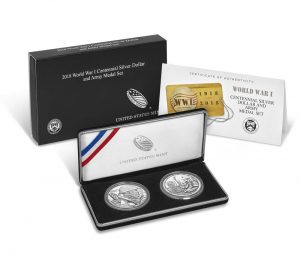
World War I Centennial 2018 Silver Dollar and Army Medal Set
Since there are no more surviving veterans of World War I, one can only assume that the commemorative coin and medal sets are being marketed to those that want to remember the service of those veterans. Creating these sets in this context makes sense. It does not make sense for the collector or for someone whose family did not serve in World War I or wants to just collect the medals.
This short-sightedness by the U.S. Mint may hinder potential sales of the commemorative coin whose proceeds are to benefit the United States Foundation for the Commemoration of the World Wars, an organization responsible for making sure we do not forget those who served.
With the decline in silver prices and the market interest in investing in silver at its lowest since before the Great Recession, a short-sighted decision like this will limit the sale of silver medals. This will lower the income and seigniorage the U.S. Mint will collect after seeing a decline in the sales of bullion-related products.
If the U.S. Mint cannot get this right, then maybe they should have a more broad community discussion so they can better understand the potential collector market because on this, they bombed!
Images courtesy of the U.S. Mint.
Jan 4, 2018 | news, policy, US Mint
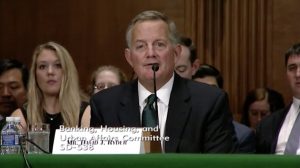
David J. Ryder at the hearing regarding his nomination to be the 39th Director of the U.S. Mint
Officially, Ryder’s nomination was “[returned] to the President under the provisions of Senate Rule XXXI, paragraph 6 of the Standing Rules of the Senate.”
Senate Rule XXXI, paragraph 6 states:
Nominations neither confirmed nor rejected during the session at which they are made shall not be acted upon at any succeeding session without being again made to the Senate by the President; and if the Senate shall adjourn or take a recess for more than thirty days, all nominations pending and not finally acted upon at the time of taking such adjournment or recess shall be returned by the Secretary to the President, and shall not again be considered unless they shall again be made to the Senate by the President.
However, according to the Congressional Research Service (CRS Report RL31980):
The Senate can, however, waive this rule by unanimous consent, and it often does to allow nominations to remain “in status quo” between the first and second sessions of a Congress or during a long recess. The majority leader or his designee also may exempt specific nominees by name from the unanimous consent agreement, allowing them to be returned during the recess or adjournment.

Senate Majority Leader Mitch McConnell (R-KY)
There should be no reason to reject Ryder’s nomination. Aside from being previously confirmed by the Senate, there was no issue with Ryder’s confirmation hearing. In fact, his hearing was considered a pro forma session because of his past experience with the U.S. Mint and commercial Secure Products, a company focused on developing anti-counterfeiting solutions for currency and branded products.
This is clearly a political move by McConnell who has his issues with the president while polls show the popularity of both men is declining. McConnell may be trying to calculate what it will take to hold the Senate this November in an election that is seen to be potentially contentious. McConnell ask has to consider that his term is up in 2020. If he does not retire, he would have to run alongside the president. It might help McConnell to poke the president in the eye when he has the chance.
It has been seven years since Edmund Moy resigned as Director of the U.S. Mint. Since January 2011, there have been three nominations that the Senate has not considered (Bibiana Boerio & Rhett Jeppson by Obama and currently Ryder). At this rate, will anyone accept a nomination given the Senate’s record of inaction? Or will the U.S. Mint have to accept a less than optimal candidate because nobody else will take the job?
Gallery of Rejected Nominees to be Director of the U.S. Mint
-

-
Bibiana Boerio was nominated in Sept 2010 but never acted on by the Senate.
-

-
Rhett Jeppson was nominated in July 2015 and even had a hearing, but his nomination was not acted on in the Senate.
-

-
David J. Ryder, Director of the U.S. Mint.
Jan 2, 2018 | commemorative, policy, US Mint
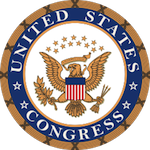 Each two-year term of congress is marked by sessions that begin every January 3rd at noon. When the House and Senate gavel into session on January 3, 2018, it will be the second session of the 115th Congress.
Each two-year term of congress is marked by sessions that begin every January 3rd at noon. When the House and Senate gavel into session on January 3, 2018, it will be the second session of the 115th Congress.
Political watchers have called the 115th congress everything from contentious to partisan to dysfunctional to names that cannot be repeated to a family audience. One thing they have not called this congress: boring.
For numismatists, Congress did pass The American Legion 100th Anniversary Commemorative Coin Act (Public Law No. 115-65) making it the second commemorative coin program for 2019. The Apollo 11 50th Anniversary commemorative is the other. Also, two bills passed the House and have been sent to the Senate for their consideration:
- Saint-Gaudens National Historical Park Redesignation Act (H.R. 965)
This bill redesignates the Saint-Gaudens National Historic Site, in New Hampshire, as the “Saint-Gaudens National Historical Park.”
- Naismith Memorial Basketball Hall of Fame Commemorative Coin Act (H.R. 1235)
This bill creates the first commemorative coin program in 2020 in recognition and celebration of the Naismith Memorial Basketball Hall of Fame in Springfield, Massachusetts.
In between the partisan wrangling, there were three bills were introduced in Congress last month. They are as follows:
H.R. 4539: Plymouth 400th Anniversary Commemorative Coin Act of 2017
Referred to the House Committee on Financial Services. — Dec 4, 2017
S. 2189: Plymouth 400th Anniversary Commemorative Coin Act of 2017
Read twice and referred to the Committee on Banking, Housing, and Urban Affairs. — Dec 4, 2017
H.R. 4732: National Law Enforcement Museum Commemorative Coin Act
Referred to the House Committee on Financial Services. — Dec 21, 2017
In the meantime, the nomination of David Ryder to be the next Director of the U.S. Mint is now 73rd on the Senate Executive Calendar, down from 70th last month. A few nominations for key administrative positions were added to the calendar in front of Ryder. It is possible that his nomination will be confirmed within the next two months.
PN1082: David J. Ryder — Department of the Treasury
Date Received from President: October 5, 2017
Summary: David J. Ryder, of New Jersey, to be Director of the Mint for a term of five years, vice Edmund C. Moy, resigned.
Received in the Senate and referred to the Committee on Banking, Housing, and Urban Affairs. — Oct 5, 2017
Committee on Banking, Housing, and Urban Affairs. Hearings held. — Oct 24, 2017
Committee on Banking, Housing, and Urban Affairs. Ordered to be reported favorably. — Nov 1, 2017
Reported by Senator Crapo, Committee on Banking, Housing, and Urban Affairs, without printed report. — Nov 1, 2017
Placed on Senate Executive Calendar. Calendar No. 458. Subject to nominee’s commitment to respond to requests to appear and testify before any duly constituted committee of the Senate. — Nov 1, 2017
Dec 24, 2017 | coins, news, US Mint
News cycles seem to be quiet lately. I wonder what is going on in the world?! 😉
All kidding aside, this past week appears that people are rushing to complete whatever tasks are at hand before the holiday weekend and the end of the year. With everyone celebrating, I am not anticipating anything earth shattering from any news sector.
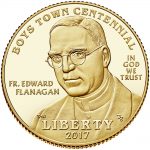
The Boys Town Centennial Commemorative coin features Fr. Edward Flanagan, founder of Boys Town

2017 Lions Clubs Commemorative Silver Dollar Proof Obverse
Remember, the U.S. Mint only accepts orders via their website or by calling 800-USA-MINT (800-872-6468).
And now the news…

December 18, 2017
The Treasury Department will propose the production of coins bearing the face of His Majesty King Maha Vajiralongkorn Bodindradebayavarangkun to the cabinet on Tuesday. Pachara Anantasin, the director-general of the Treasury Department, said Sunday the proposal will be tabled at the day's cabinet meeting.  → Read more at bangkokpost.com
→ Read more at bangkokpost.com

December 18, 2017
Justice League star Henry Cavill's tradition of giving out "challenge coins" continues and this time it's not just the crew of films he's working on receiving the thoughtful token. Comic book writer and artist Tony Daniel took to Instagram today to share a photo of special token that the Superman actor had sent him.  → Read more at comicbook.com
→ Read more at comicbook.com

December 18, 2017
The Alaska Mint released its 2018 state coin design this month. Designed by a local university student, Megan Warren found influence for her design from growing up in Alaska and her Native Alaskan Tlingit heritage.  → Read more at anchoragepress.com
→ Read more at anchoragepress.com

December 21, 2017
Rezwan Razack is building a museum to showcase his collection of Indian paper money dating back to 1812.  → Read more at qz.com
→ Read more at qz.com

December 22, 2017
The news was celebrated by the Institute of Scrap Recycling Industries and has been a priority for Covanta.  → Read more at wastedive.com
→ Read more at wastedive.com

December 23, 2017
The “challenge coin” no longer features the presidential seal or national motto. But it does have “Make America Great Again” — twice.  → Read more at washingtonpost.com
→ Read more at washingtonpost.com
Dec 2, 2017 | legislative, news, US Mint
 Most of the work in Congress has been on the tax bill (H.R. 1) and non-controversial legislation. The Senate has worked on reducing the number of presidential nominees on the Executive Calendar. Currently, there are 100 nominations waiting to be acted on and David J. Ryder, nominated to be the Director of the U.S. Mint, is 70th on the calendar, up from 126th last month.
Most of the work in Congress has been on the tax bill (H.R. 1) and non-controversial legislation. The Senate has worked on reducing the number of presidential nominees on the Executive Calendar. Currently, there are 100 nominations waiting to be acted on and David J. Ryder, nominated to be the Director of the U.S. Mint, is 70th on the calendar, up from 126th last month.
PN1082: David J. Ryder — Department of the Treasury
Date Received from President: October 5, 2017
Summary: David J. Ryder, of New Jersey, to be Director of the Mint for a term of five years, vice Edmund C. Moy, resigned.
Received in the Senate and referred to the Committee on Banking, Housing, and Urban Affairs. — Oct 5, 2017
Committee on Banking, Housing, and Urban Affairs. Hearings held. — Oct 24, 2017
Committee on Banking, Housing, and Urban Affairs. Ordered to be reported favorably. — Nov 1, 2017
Reported by Senator Crapo, Committee on Banking, Housing, and Urban Affairs, without printed report. — Nov 1, 2017
Placed on Senate Executive Calendar. Calendar No. 458. Subject to nominee’s commitment to respond to requests to appear and testify before any duly constituted committee of the Senate. — Nov 1, 2017
Nov 2, 2017 | legislative, US Mint

David J. Ryder
Committee Chairman Sen. Mike Crapo (R-ID) reported the committee’s recommendation without a printed report. His nomination was added to the Senate Executive Calendar for a vote by the full Senate.
With Ryder’s addition, there are 126 nominations pending for a vote in the Senate. The Senate has not approved a presidential nomination since June 8, 2017.
PN1082: David J. Ryder — Department of the Treasury
Date Received from President: October 5, 2017
Summary: David J. Ryder, of New Jersey, to be Director of the Mint for a term of five years, vice Edmund C. Moy, resigned.
Received in the Senate and referred to the Committee on Banking, Housing, and Urban Affairs. — Oct 5, 2017
Committee on Banking, Housing, and Urban Affairs. Hearings held. — Oct 24, 2017
Committee on Banking, Housing, and Urban Affairs. Ordered to be reported favorably. — Nov 1, 2017
Reported by Senator Crapo, Committee on Banking, Housing, and Urban Affairs, without printed report. — Nov 1, 2017
Placed on Senate Executive Calendar. Calendar No. 458. Subject to nominee’s commitment to respond to requests to appear and testify before any duly constituted committee of the Senate. — Nov 1, 2017
Nov 1, 2017 | coins, commemorative, legislative, US Mint
 It seems that when I write these posts about the monthly numismatic-related legislation reviews, I note how frustrating it is to follow the workings of Congress. Even though I work as a part-time political analyst and have some contacts I can leverage, even the insiders cannot explain why things happen.
It seems that when I write these posts about the monthly numismatic-related legislation reviews, I note how frustrating it is to follow the workings of Congress. Even though I work as a part-time political analyst and have some contacts I can leverage, even the insiders cannot explain why things happen.
Let’s look at recent legislation. Even though the House passed both the The American Legion 100th Anniversary Commemorative Coin Act (H.R. 2519) and the Naismith Memorial Basketball Hall of Fame Commemorative Coin Act (H.R. 1235) on the same day and sent both the Senate at the same time, the Senate only passed one of the bills while the other is languishing in committee.
Commemorative coin bills are not a big priority for Congress. Most of the time, they are treated as favors for one member or another, along the lines of “you help me with mine and I will help you with yours.” These are not big issues but are used to win points with constituents back home.
Although nobody is sure of the reasons why the Naismith Memorial Basketball Hall of Fame Commemorative Coin Act is being stalled in committee, it may be because of politics and personality conflicts. Usually, when one of these bills are introduced, a version will be submitted to the House and Senate hoping one will pass. The Senate version, S. 1503 was introduced by Sen. Elizabeth Warren (D-MA). Sen. Warren is not a favorite amongst her colleagues on the other side of the aisle. My sources speculate that the Senate’s leadership could be using this as a future bargaining chip against some of her principled stances.
It does not matter what you think about Sen. Warren or her politics. This is the way Congress works. If you think that the Basketball Hall of Fame should have a commemorative coin to celebrate its 60th anniversary in 2020, then let your senators know that you support H.R. 1235 that has already passed the House.
H.R. 965: Saint-Gaudens National Historical Park Redesignation Act
Summary: This bill redesignates the Saint-Gaudens National Historic Site, in New Hampshire, as the “Saint-Gaudens National Historical Park.”
Referred to the Subcommittee on Federal Lands. — Feb 23, 2017
Ordered to be Reported (Amended) by Unanimous Consent. — Jul 26, 2017
Placed on the Union Calendar, Calendar No. 197. — Aug 25, 2017
Motion to reconsider laid on the table Agreed to without objection. — Oct 2, 2017
Received in the Senate and Read twice and referred to the Committee on Energy and Natural Resources. — Oct 3, 2017
H.R. 2519: The American Legion 100th Anniversary Commemorative Coin Act
Summary: This bill requires the Department of the Treasury to mint and issue commemorative coins in recognition and celebration of the 100th anniversary of the American Legion.Surcharges received from the sale of these coins shall be paid to the American Legion for costs related to promoting the importance of: (1) caring for those who have served, and those who are still serving, in the Armed Forces; and (2) maintaining patriotic values, strong families, and assistance for at-risk children.
Referred to the House Committee on Financial Services. — May 18, 2017
Motion to reconsider laid on the table Agreed to without objection. — Sep 25, 2017
Received in the Senate. — Sep 26, 2017
Message on Senate action sent to the House. — Sep 29, 2017
Presented to President. — Sep 29, 2017
Became Public Law No: 115-65. — Oct 6, 2017
H.R. 4044: 75th Anniversary of the End of World War II Commemorative Coin Act
Referred to the House Committee on Financial Services. — Oct 12, 2017
PN1082: David J. Ryder — Department of the Treasury
Date Received from President: October 5, 2017
Summary: David J. Ryder, of New Jersey, to be Director of the Mint for a term of five years, vice Edmund C. Moy, resigned.
Received in the Senate and referred to the Committee on Banking, Housing, and Urban Affairs. — Oct 5, 2017
Committee on Banking, Housing, and Urban Affairs. Hearings held. — Oct 24, 2017
Oct 30, 2017 | coin design, coins, Eagles, platinum, US Mint
Over a week ago, the U.S. Mint announced that they will begin a three-year series of the American Platinum Eagles proof coins featuring designs inspired by the Declaration of Independence. After looking at the designs and the designs of past platinum proof coins, they may be one of the most under-appreciated series of coins produced by the U.S. Mint.
-
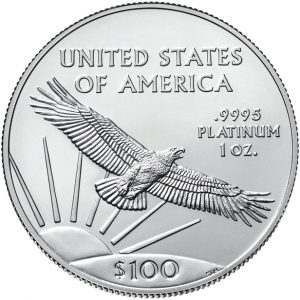
-
American Platinum Eagle bullion reverse design
-
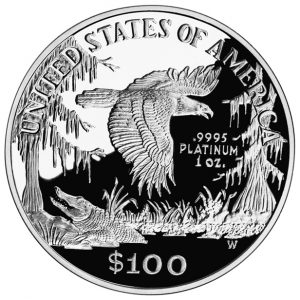
-
1999 American Platinum Eagle Proof reverse – Vistas of Liberty Reverse Designs – Eagle Above Southeastern Wetlands
-
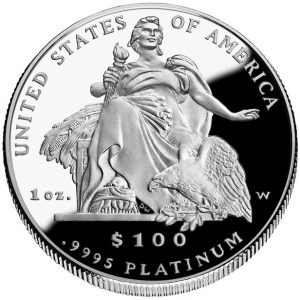
-
2004 American Platinum Eagle proof reverse – Daniel Chester French’s “America” that sits before the U.S. Customs House in New York City.
Since its introduction in 1997, the U.S. Mint has produced four series of proof coins with the reverse honoring different aspects of the nation. To see the list, see the “U.S. Coins by Type” page.
What distinguishes these coins are the well-executed reverse designs that few get to see or pay attention. It may be difficult for the average collector to consider collecting these coins because of the price of platinum has been either on par or higher than the price of gold. Also, platinum is not as well regarded as gold or silver as a precious metal causing it to be overlooked.
-

-
2006 American Platinum Eagle proof reverse – Branches of Government Series – “Legislative Muse” representing Legislative Branch
-
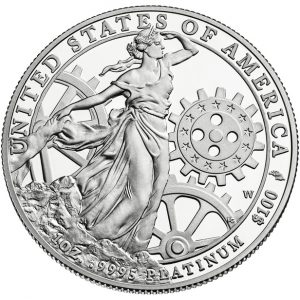
-
2013 American Platinum Eagle proof reverse – Preamble Series – “To Promote the General Welfare”
-

-
2016 American Platinum Eagle proof reverse – Nations Core Values – “Liberty and Freedom”
Since many of these coins did not sell in large quantities, many could be classified as modern rarities. But do not let the lack of supply dissuade you. Prices could be in the range of their bullion value plus a modest numismatic premium because the demand is also lower.
It is too bad these designs are confined to platinum coins. Unfortunately, the authorizing laws allow the U.S. Mint to do this with the platinum coins but not with silver. Since silver is more affordable for the average collector, maybe it is worth trying to ask Congress to change the law to allow these types of series for the American Silver Eagle proof coins.
Coin images courtesy of the U.S. Mint.
Oct 25, 2017 | news, policy, US Mint

David J. Ryder at the hearing regarding his nomination to be the 39th Director of the U.S. Mint
As part of his opening statement, Ryder had noted that he worked for Secure Products, a company focused on developing anti-counterfeiting solutions for currency and branded products. When the company was bought out by the Honeywell Corporation in 2007, he continued to work in that division with Honeywell. What was interesting was that Ryder testified that he was involved in the development of the Royal Mint’s new 12-sided one-pound coin. He said:
Interestingly, one of my last duties while at Honeywell was a joint project with The Royal Mint of the United Kingdom where we assisted them in the development of the new UK One Pound Coin, which was introduced earlier this year. This new circulating coin is considered to be the most advanced and secure coins in circulation today.
Two takeaways from the hearing:
- It appears that Ryder should be confirmed by the Senate when the nomination is sent to the floor for a vote.
- When questioned by Sen. Thom Tillis (R-NC), Ryder addresses coinage security issues specifically with bullion coins and Chinese counterfeits. Addressing his awareness of these issues is good for both the U.S. Mint and the entire numismatic industry.
Video of the nomination hearing and the opening statements can be found on the committee website.
Hearing Video Notes
- The video opens with a silent billboard. The hearing starts at 16:44 of the video.
- Committee Chairman Mike Crapo (R-ID) gives his opening statement
- Committee Ranking Member Sherrod Brown (D-OH) gives his opening statement
- Opening statements by the nominees are offered, starting with David J. Ryder at 23:40 on the video
- 48:45-51:22 Sen. Richard Shelby (R-AL) asks about an Inspector General report expanding technology at the U.S. Mint.
- 1:39:40-1:40:30 Sen Tom Cotton (R-AR) “What are the biggest changes have you seen at the Mint from when you were the director 25 years ago”
- 1:47:05-1:49:22 Sen Thom Tillis (R-NC) Question on the future of the Mint and security.
PN1082: David J. Ryder — Department of the Treasury
Date Received from President: October 5, 2017
Summary: David J. Ryder, of New Jersey, to be Director of the Mint for a term of five years, vice Edmund C. Moy, resigned.
Received in the Senate and referred to the Committee on Banking, Housing, and Urban Affairs. — Oct 5, 2017
Committee on Banking, Housing, and Urban Affairs. Hearings held. — Oct 24, 2017
Oct 18, 2017 | cents, coins, currency, dollar, Federal Reserve, US Mint
Could the recent cyber attacks and growing severity of cybersecurity issues become the motivation for Congress to vote to reform United States currency?
According to Philip Diehl and Edmund Moy, former Directors of the U.S. Mint, the discussion as to remove the cent and paper dollar from circulation should be part of the current budget and tax overhaul debates.
-

-
Philip N. Diehl
35th Director of the U.S. Mint
June 1994 — March 2000
-

-
Edmund C. Moy
38th Director of the U.S. Mint
September 2006 — January 2011
The discussion is the same as it has been. The cost of zinc has risen causing the manufacturing costs of the Lincoln cent to climb above its face value. Even with operating efficiencies that have brought down the cost of manufacturing to its lowest levels in many years, the price of zinc keeps makes the materials cost more than the coin is worth.
As for the paper dollar, the Government Accountability Office has published several reports over the years that demonstrate the cost savings between using the paper dollar versus a coin dollar. The last GAO report (GAO-13-164T) concluded that using a dollar coin instead of the paper note “could potentially provide $4.4 billion in net benefits to the federal government over 30 years.”
This is not a new discussion. The only change is that this is being suggested by former Directors of the U.S. Mint from both sides of the aisle. Diehl was appointed by Bill Clinton and served from June 1994 through March 2000. Moy was appointed by George W. Bush and served from September 2006 through January 2011.
Earlier this year, Sen. John McCain (R-AZ) introduced the Currency Optimization, Innovation, and National Savings Act of 2017 (COINS Act) (S. 759). McCain’s bill would require:
- Suspending the production of the one-cent coin for 10 years except for collectibles. After three years, the GAO would doe a study to determine whether production should remain suspended or should be reinstated. This would not demonetize the cent.
- Change the composition of the nickel to 80-percent copper and 20-percent nickel. This should bring down the cost of materials used in striking the five-cent coin to be on par with its value. Efficiencies in manufacturing could lower costs further.
- If the bill becomes law, two years after it is enacted, the Federal Reserve will begin removing $1 Federal Reserve Notes from circulation. This will probably be done by the banks who will take the notes on deposit and send them back to the Federal Reserve where they will be destroyed. Coins would take their place. The $1 FRN could still be produced for the collector market.
Sources report that the chances of McCain’s bill getting a hearing are minuscule. While having lunch with on congressional staffer, I was given three reasons why Congress will not address this issue:
- States with a large rural population primarily west of the Mississippi River represented by Republicans are unlikely to support the removal of the one-cent coin. Removal of the coin is viewed as a hidden tax against the people with fear mongering that suggest the government is keeping the extra money that would become on the rounding of prices.
- States with large poor populations, primarily in the south, and their advocates who believe that taking away the pennies are a way to separate more money from poor people who can least afford to lose the ability to pay in cents.
- Surveys show that most of the people older than Millenials are against removing the paper dollar. Since this population constitutes the majority of the voters and donors, the politicians are not about to make those people upset.
Another issue is that McCain is not popular amongst his fellow Republicans. If the issue is addressed, it is likely to be discussed as part of a bill that does not bear McCain’s sponsorship.
Given the partisan nature of politics and the perceptions of the members of Congress, there is a very little chance of the Coins Act or any similar legislation being enacted during this session of Congress.







 Each two-year term of congress is marked by sessions that begin every January 3rd at noon. When the House and Senate gavel into session on January 3, 2018, it will be the second session of the 115th Congress.
Each two-year term of congress is marked by sessions that begin every January 3rd at noon. When the House and Senate gavel into session on January 3, 2018, it will be the second session of the 115th Congress.

 → Read more at
→ Read more at 








